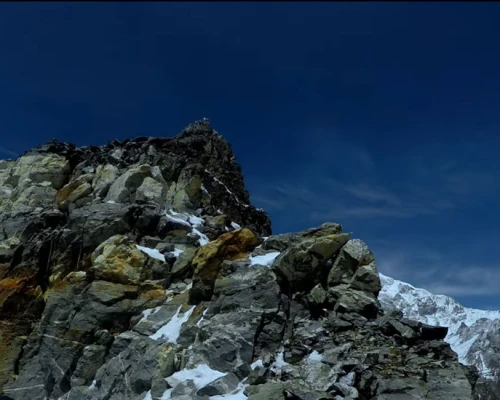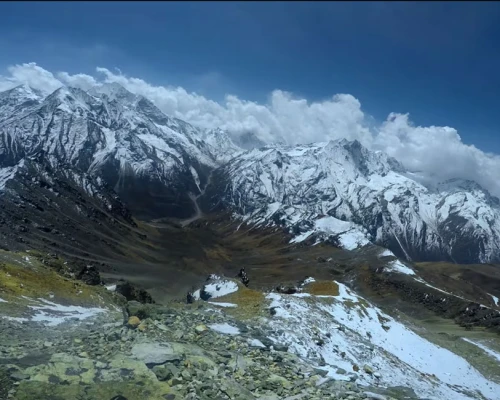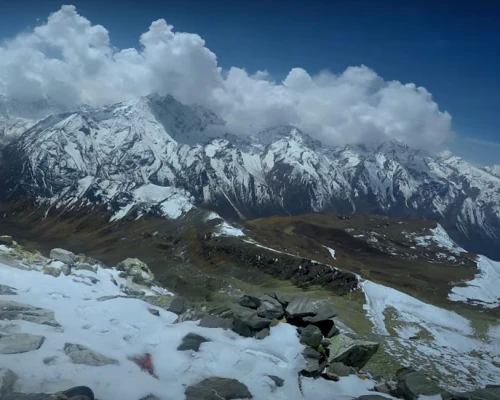The Langtang region of Nepal features Yala Peak as a well-known trekking peak that reaches 5,520 meters in height and provides mountaineering opportunities without demanding technical expertise. For climbers, opportunities to learn basic mountaineering skills with mesmerizing mountain views. Yala Peak Climbing serves as one of the elements of the Langtang National Park which displays its diverse wildlife and traditional Tamang settlements and spectacular mountain views.
The first step of reaching Yala Peak starts with taking a picturesque drive from Kathmandu to Syabrubesi which marks the entrance to the Langtang Valley. The path leads higher into forests of rhododendrons and then passes terraced land and friendly mountain communities. The journey leads climbers to Kyanjin Gompa where they encounter the important Buddhist monastery that functions as the last significant village before starting their ascent. Trekkers need to complete the acclimatization process before they can explore Yala Peak and its surrounding glaciers and ridges.
The Yala Peak climb demands basic mountaineering equipment that includes crampons and ropes with ice axes for safety. The climb requires no specialized skills but climbers need to handle steep icy slopes and areas with rocks. The summit rewards adventurers with breathtaking panoramas of Shishapangma (8,013m), Dorje Lakpa, Langtang Lirung, and other towering peaks of the Himalayas. The sensation of reaching the Yala Peak summit stands alone as it rewards every step of the journey.
After completion of descent, you will have another opportunity to witness the natural splendor and cultural heritage of the region. Yala Peak stands as an ideal first Himalayan mountaineering experience because it combines accessible climbing routes with spectacular views throughout Langtang Valley. This adventurous Yala Peak expedition unites trekking activities with climbing activities to deliver a perfect Himalayan experience.
Yala Peak Climbing Difficulty
Yala Peak stands as a simple trekking peak in Nepal which suits both novice climbers and experienced trekkers who want to scale high-altitude peaks. The non-technical classification of Yala Peak does not eliminate the various challenges climbers will face since they need proper preparation together with physical fitness and acclimatization. The primary elements determining the climbing difficulty of Yala Peak are altitude level combined with terrain features and weather conditions and with previous trekking experience.
9 Days Yala Peak climbing poses its main difficulty from the peak's elevated altitude. The summit elevation reaches 5,520 meters so altitude sickness poses a risk mainly for those who did not have enough time to acclimatize. Proper precautions during the Langtang Valley trek should be taken to prevent symptoms like headaches alongside dizziness and nausea because the gradual ascent allows adaptation time. Additional days for acclimatization combined with proper hydration and steady progress will reduce the potential risks during this expedition.
The terrain elements increase the overall challenge of the adventure. The path to Yala Peak Base Camp follows defined trails that pass through forests and meadows and villages but the final part of the climb requires traversing rocky ridges and snow-covered slopes. Basic mountaineering equipment such as crampons, ropes, and ice axes becomes necessary for climbers but technical climbing skills remain unnecessary for the climb. Climbing Yala Peak becomes simpler for those who have previously engaged in trekking and understand basic equipment operation.
The level of physical fitness directly affects how difficult Yala Peak climbing will become for each person. The trekking peak features moderate difficulty but climbers need excellent stamina and endurance to handle its long walks and steep slopes and high-altitude environment. Climbers who train with cardio exercises and strength-building workouts and practice hikes at elevated elevations build better readiness for upcoming challenges.
Best Season For Yala Peak Climbing
The selection of proper seasons for Yala Peak climbing determines both safety and enjoyment during the expedition. The spring months from March to May along with the autumn months from September to November provide the most suitable conditions for Yala Peak climbing. Nepal offers its best trekking and peak climbing opportunities during these particular seasons.
Spring (March to May)
Climbers choose spring as the most preferred time to scale Yala Peak. The climate during this season presents mild conditions where days offer pleasant temperatures alongside cold but bearable nights. The Langtang Himalayan range reveals itself through clear skies during this season. The hiking trails become colorful during this time as rhododendrons and other wildflowers transform the landscape into a vibrant sight. The stable snow conditions during spring after winter months create predictable conditions which makes climbing Yala Peak safer.
Autumn (September to November)
Yala Peak climbing finds its perfect window during autumn because stable meteorological conditions prevail at this time. The post-rain period brings fresh air that provides outstanding visibility for viewing mountains. Climbers and trekkers experience a pleasant climate during this season which enables them to perform their activities with ease. The trails remain safe during the post-monsoon period because the conditions are dry and free from mud and slippery surfaces. The Langtang region becomes lively during this season because numerous trekkers and climbers visit. Travelers who visit during autumn can witness Nepali cultural traditions because major festivals like Dashain and Tihar occur at this time.
Seasons to Avoid
The climbing route of Yala Peak remains accessible throughout the year yet summertime and wintertime conditions seriously affect the mountaineering experience. During the monsoon season, heavy rains create dangerous trail conditions because the paths become slippery while landslides occur frequently and path navigation becomes difficult. Clouds that cover the mountain area prevent viewers from seeing their surroundings which diminishes the overall scenic value. During winter months the peak becomes very challenging because heavy snowfall and strong winds create dangerous conditions for climbers. The attempt at Yala Peak requires experienced climbers who must bring proper high-altitude winter equipment during these months.
The spring and autumn seasons represent the best times to climb Yala Peak in the Langtang region since they provide safer conditions and enhanced visual appeal.






 based on 1 review
based on 1 review
